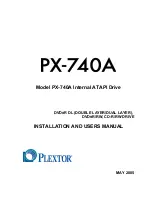
MAINTENANCE
Troubleshooting
29
MAINTENANCE
Troubleshooting
System Diagnostics Fault History
The drive continuously monitors system performance and can detect a variety of abnormal conditions. In
many cases, the drive compensates as needed to maintain continuous system operation; however, if there is
a high risk of equipment damage, the drive will stop the system and display the fault condition. If possible,
the drive will try to restart itself when the fault condition subsides.
Each time a fault is detected in the system, the drive records the fault to the Event Log. The Event Log can be
written to a USB flash drive for subsequent viewing or email.
NOTE:
A good quality USB 2.0 compliant (or newer) device is required. Some older or lower-cost devices
may not be recognized by the drive.
Use the following procedure to download the log file:
1.
Remove power from the drive and allow a couple of minutes for internal voltage to dissipate.
2. Remove the drive cover.
3. Insert the USB device into the USB port on the lower-left corner of the circuit board.
4. Reinstall the drive cover before applying power to the drive.
5. Apply power to the drive. The firmware readout procedure will begin automatically.
NOTE:
If the USB device contains a firmware file that is different than the firmware currently installed
on the drive, the firmware update procedure will begin, and a log file will not be written. Refer to
“Firmware Update Procedure” on page 36
for more information.
•
Power and Running LEDs flash together at a rate of 1 flash/second while the log file is being writ
-
ten to the USB device.
•
Power, Running, and Fault LEDs all flash together at a rate of 1 flash/second when the log file write
process is complete.
6. Remove power from the drive and allow 5 minutes for internal voltages to dissipate.
7. Remove the drive cover.
8. Remove the USB storage device.
9. Reinstall the drive cover before applying power.
10. Restore power to the drive. The drive returns to normal operation.
















































